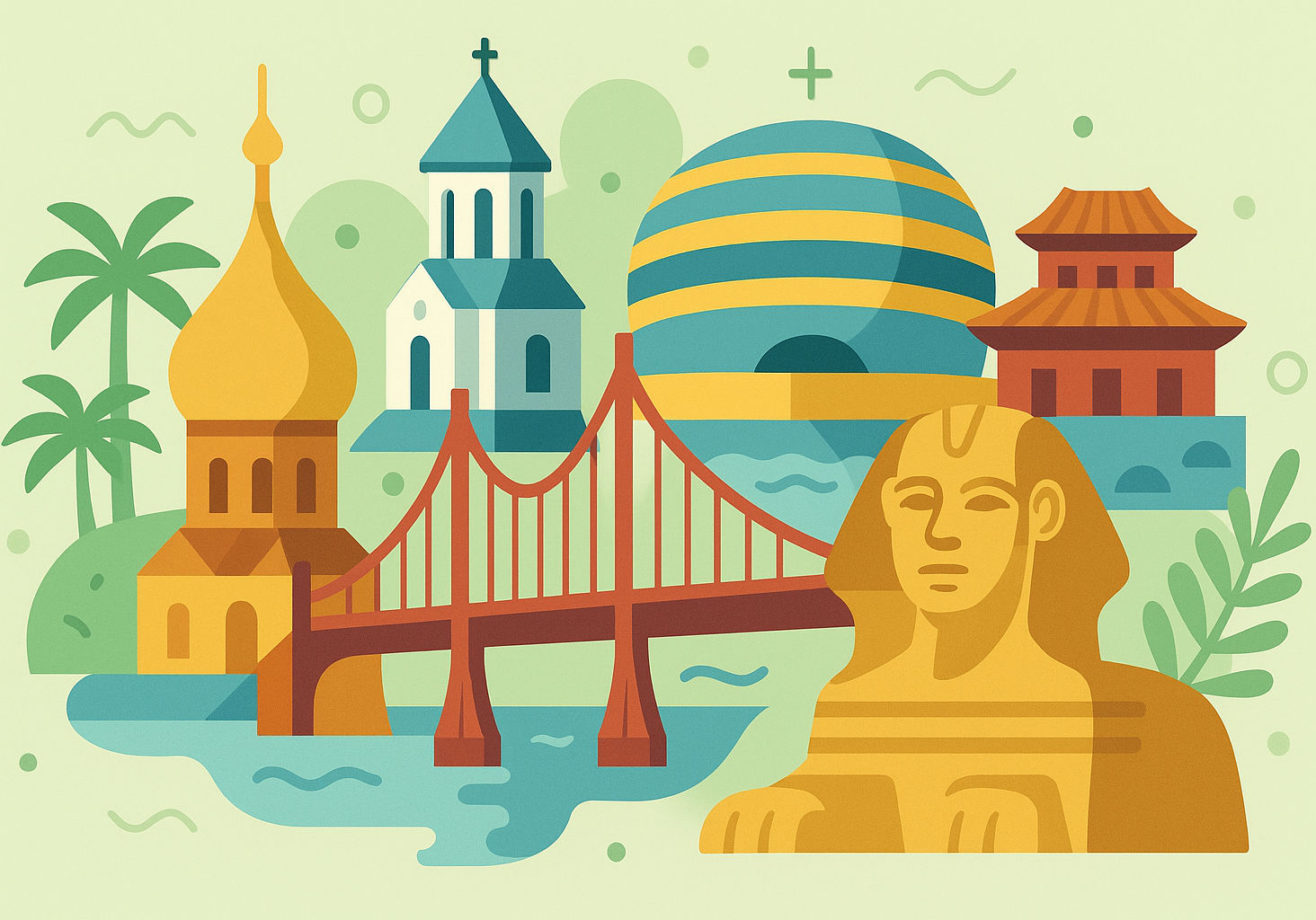Top 10 Places for Spiritual Journeys
September 11, 2025
Throughout history, people have embarked on spiritual journeys to find deeper meaning, reconnect with themselves, and experience a sense of transcendence beyond the daily routine of life. These journeys often combine the power of sacred places, natural beauty, and cultural traditions to guide individuals toward renewal and enlightenment. In today’s fast-paced world, the need for such experiences is greater than ever. Travelers seek destinations that offer not only breathtaking landscapes but also spaces for reflection, meditation, and healing.
The most remarkable spiritual travel destinations are not confined to a single religion or philosophy. Instead, they welcome people from all backgrounds to explore rituals, history, and energy that has shaped humanity for centuries. From ancient temples and monasteries to mountains, deserts, and mystical towns, these locations provide powerful opportunities to pause, reflect, and grow.
This article explores the top 10 places for spiritual journeys, highlighting their unique atmospheres, cultural significance, and the ways they inspire transformation. Each destination offers an invitation to step away from the noise of modern life and immerse yourself in practices and landscapes that foster peace and clarity. Whether you are seeking inner healing, creative inspiration, or simply a deeper connection to the world around you, these places promise experiences that leave lasting impressions on both the soul and the spirit.
10. Mount Sinai, Egypt

Rising from the rugged landscape of the Sinai Peninsula, Mount Sinai is one of the most revered spiritual travel destinations in the Middle East. According to tradition, it is the place where Moses received the Ten Commandments, making it a sacred site for Jews, Christians, and Muslims alike. Pilgrims have climbed the mountain for centuries to connect with its spiritual legacy.
The journey to the summit is both physical and symbolic. Travelers often begin the climb at night, reaching the peak in time to witness the sunrise, when the desert landscape is bathed in golden light. The view is awe-inspiring and deeply moving, regardless of one’s religious background. At the top, a small chapel and mosque stand side by side, symbolizing the mountain’s significance across faiths.
Local advice suggests hiring a Bedouin guide, who can share cultural stories and ensure a safe trek. Many describe the experience of climbing Mount Sinai as a powerful moment of humility and reflection. For those seeking a spiritual journey in Egypt, Mount Sinai provides an unforgettable connection to history, faith, and the enduring search for meaning.
9. Rishikesh, India

Nestled at the foothills of the Himalayas, Rishikesh is known as the world capital of yoga and a magnet for spiritual seekers from around the globe. The town sits along the sacred Ganges River, where ashrams, yoga centers, and meditation retreats line the riverbanks. Rishikesh gained global fame when the Beatles visited in the 1960s, but its spiritual importance has been established for centuries.
Travelers come to Rishikesh to practice yoga, attend satsangs with spiritual teachers, and participate in the Ganga Aarti, a nightly ritual of music and offerings performed along the river. The atmosphere is infused with devotion, making it a vibrant and inspiring place for self-discovery.
Local tips include exploring the suspension bridges that connect the two sides of town, where monkeys leap between trees and travelers gather in lively cafés. Many also venture into the nearby Himalayas for treks that combine natural beauty with spiritual reflection. As one of the most dynamic spiritual destinations in India, Rishikesh provides both tradition and modern wellness, offering transformative experiences for body, mind, and soul.
8. Mount Athos, Greece

Known as the Holy Mountain, Mount Athos in Greece is a monastic republic that has been a center of Orthodox Christian spirituality for over a thousand years. Located on a peninsula in northern Greece, it is home to more than 20 monasteries where monks devote their lives to prayer, contemplation, and ascetic practices. The atmosphere is deeply spiritual, shaped by centuries of devotion and tradition.
Visiting Mount Athos is a rare experience, as entry is restricted and requires special permission. Only men are allowed, following long-standing tradition, and visitors must adhere to strict rules during their stay. Those who enter find themselves immersed in a way of life untouched by modern distractions, where time moves according to the rhythm of prayer and the natural cycle of day and night.
Local advice emphasizes the importance of approaching Mount Athos with humility and respect. Pilgrims often describe the experience as transformative, not only for its religious significance but for the simplicity and sincerity of life within the monasteries. For those able to visit, Mount Athos is one of the most authentic and profound spiritual journeys in Greece, offering insight into a living tradition of faith.
7. Santiago de Compostela, Spain

The Camino de Santiago pilgrimage culminates in Santiago de Compostela, a city in northwestern Spain that has drawn spiritual travelers for centuries. Pilgrims walk hundreds of kilometers across Spain and Europe to reach the city’s grand cathedral, believed to house the remains of Saint James the Apostle. The journey itself is as significant as the destination, symbolizing spiritual growth, self-discovery, and connection with fellow travelers.
The cathedral is a magnificent centerpiece of the city, where pilgrims gather to attend mass and reflect on their journey. The atmosphere is filled with both reverence and camaraderie, as people from diverse backgrounds share the common experience of walking the Camino.
Local advice suggests exploring the smaller chapels and historic streets of Santiago to fully appreciate its medieval charm. Many pilgrims describe the emotional release of reaching the cathedral square after weeks of walking, a moment of triumph and gratitude. For those seeking a spiritual journey in Europe, Santiago de Compostela represents both an ending and a new beginning, blending tradition, faith, and human connection.
6. Uluru, Australia

Rising dramatically from the desert landscape of central Australia, Uluru, also known as Ayers Rock, is one of the most significant spiritual landmarks for the Anangu people, the traditional custodians of the land. This massive sandstone monolith is more than just a natural wonder—it is a sacred site with deep cultural and spiritual significance. Dreamtime stories, passed down through generations, describe Uluru as a place of creation and ancestral power.
Visitors can walk around the base of Uluru to experience its size and presence up close. The rock changes color throughout the day, glowing red at sunrise and sunset, creating a deeply moving spectacle. Many sections of Uluru are sacred, and photography is restricted in certain areas to respect Indigenous traditions.
Local advice encourages visitors to join guided tours led by Anangu guides, who share cultural stories, explain ancient rock art, and provide insight into traditional practices. By engaging respectfully, travelers gain a deeper appreciation of the spiritual and cultural importance of Uluru. As one of the most powerful spiritual destinations in Australia, Uluru connects visitors to the land, the people, and the timeless rhythms of creation.
5. Mount Kailash, Tibet

Revered in multiple religions, Mount Kailash in Tibet is one of the most sacred mountains in the world. Hindus, Buddhists, Jains, and followers of Bon all consider it a holy site, symbolizing different aspects of the divine. Hindus see it as the home of Lord Shiva, while Buddhists regard it as the abode of the Buddha Demchok. Pilgrims from across Asia journey to this remote region to perform the kora, a sacred circumambulation of the mountain that is believed to bring spiritual merit and purification.
The landscape itself is stark and powerful, with snow-covered peaks rising above high-altitude plateaus. The pilgrimage route around the mountain is physically demanding, spanning over 50 kilometers, yet it is undertaken with devotion by thousands each year. Many describe the journey as transformative, blending physical endurance with profound spiritual commitment.
Local tips suggest acclimatizing in nearby towns such as Darchen before beginning the trek, as the high altitude can be challenging. Travelers often note the deep sense of humility that arises when walking alongside devoted pilgrims. For those seeking a spiritual journey in Tibet, Mount Kailash offers an unparalleled experience of faith, endurance, and transcendence.
4. Sedona, Arizona, USA

The red rock landscapes of Sedona in Arizona are famous not only for their dramatic beauty but also for their reputation as a center of spiritual energy. Many believe Sedona is home to vortex sites, where the earth’s energy is concentrated and can promote healing, clarity, and inspiration. Whether or not one subscribes to this belief, countless visitors describe feeling a unique sense of peace and renewal in Sedona’s desert landscape.
Beyond the natural energy, Sedona has become a hub for wellness retreats, yoga centers, and alternative healing practices. Visitors can participate in meditation workshops, sound baths, or guided hikes that combine physical activity with spiritual reflection. The towering red rock formations, such as Cathedral Rock and Bell Rock, serve as both hiking destinations and places for quiet contemplation.
Local advice includes timing a visit during sunrise or sunset, when the rocks glow with otherworldly colors and create a deeply moving atmosphere. Many travelers also connect with Native American traditions and storytelling, which add depth to the experience. For those seeking a spiritual journey in the United States, Sedona offers a unique blend of natural wonder and spiritual practice that leaves a lasting impression.
3. Kyoto, Japan

The city of Kyoto in Japan is often regarded as the cultural and spiritual heart of the nation. With over a thousand temples and shrines scattered throughout its landscape, Kyoto offers endless opportunities for reflection and connection. From grand Zen Buddhist temples like Kinkaku-ji, the Golden Pavilion, to serene Shinto shrines nestled in the forests, every corner of Kyoto invites stillness and reverence.
The practice of Zen meditation, or zazen, is deeply embedded in Kyoto’s spiritual life. Many temples offer opportunities for visitors to participate in meditation sessions guided by monks. The city’s carefully designed gardens, with raked sand, mossy stones, and perfectly placed trees, embody the Japanese aesthetic of simplicity and harmony, encouraging mindfulness and contemplation.
Local tips recommend visiting Fushimi Inari Shrine with its iconic red torii gates winding up the hillside. Walking through the thousands of gates creates a meditative rhythm that many find grounding. Kyoto is also known for tea ceremonies, which provide another path to mindfulness through ritual and attention to detail. For travelers on a spiritual journey in Asia, Kyoto provides a blend of cultural immersion, natural beauty, and timeless practices that inspire deep inner calm.
2. Machu Picchu, Peru

High in the Andes mountains, Machu Picchu in Peru stands as one of the most mysterious and awe-inspiring spiritual destinations in the world. Once a sacred Incan citadel, it embodies the advanced engineering, astronomical knowledge, and spiritual devotion of the Inca civilization. Surrounded by misty peaks and lush greenery, Machu Picchu radiates an energy that many visitors describe as deeply transformative.
Exploring the ruins, travelers encounter temples aligned with celestial events, terraces carved into steep mountainsides, and sacred stones believed to connect heaven and earth. The Temple of the Sun and the Intihuatana stone are particularly revered, thought to hold cosmic energy used in ancient rituals. The dramatic landscape amplifies the spiritual impact, as the site appears to float between the earth and sky.
Local advice suggests arriving early in the morning to witness the sunrise, when the first light touches the stones and creates an atmosphere of serenity. Hiking the Inca Trail, with its breathtaking views and spiritual significance, enhances the experience, allowing travelers to follow in the footsteps of the ancients. For those seeking a spiritual journey in South America, Machu Picchu combines natural wonder with mystical history in a way that few places on earth can match.
1. Varanasi, India

The ancient city of Varanasi in India is often described as the spiritual capital of Hinduism and one of the oldest continually inhabited cities in the world. Situated along the sacred Ganges River, Varanasi is where pilgrims come to bathe in holy waters, perform rituals for loved ones, and seek liberation from the cycle of life and death. The ghats, or stone steps leading to the river, form the heart of the city’s spiritual life, with sunrise ceremonies and evening aarti rituals that are profoundly moving to witness.
Walking through the narrow streets, travelers encounter centuries-old temples, chanting priests, and markets filled with offerings. The Kashi Vishwanath Temple, dedicated to Lord Shiva, is one of the most revered sites in the city, drawing both locals and visitors into its sacred atmosphere. Beyond ritual, Varanasi’s energy lies in its continuity of life, where ancient traditions remain alive in modern times.
Local tips suggest taking a boat ride at dawn to see the city awaken with prayers and rituals along the riverbanks. Many visitors also spend time in ashrams for meditation and yoga practice. For those on a spiritual journey in India, Varanasi offers a raw, transformative experience that blends beauty, intensity, and profound connection to the divine.
Final Thoughts
The world is filled with destinations that invite travelers to embark on spiritual journeys of reflection, healing, and discovery. From the sacred ghats of Varanasi to the mystical heights of Machu Picchu, the serenity of Kyoto gardens, and the rugged beauty of Mount Sinai, each place offers a unique opportunity to step away from daily life and connect with something greater. These journeys remind us that spirituality transcends religion, geography, and culture, uniting people in their quest for peace and understanding.
For modern travelers, visiting these sites is more than sightseeing. It is about participating in rituals, listening to local stories, and opening oneself to transformation. The most profound experiences often come not just from the destination itself, but from the journey within, sparked by the landscapes, people, and traditions encountered along the way.
As global travel becomes easier, the importance of traveling mindfully and respectfully grows. The top spiritual destinations in the world invite us to honor ancient traditions, protect sacred spaces, and carry their lessons back into our lives. Whether you are seeking renewal, inspiration, or a deeper sense of purpose, these journeys ensure that travel becomes not just a movement through space, but a path to inner awakening.


